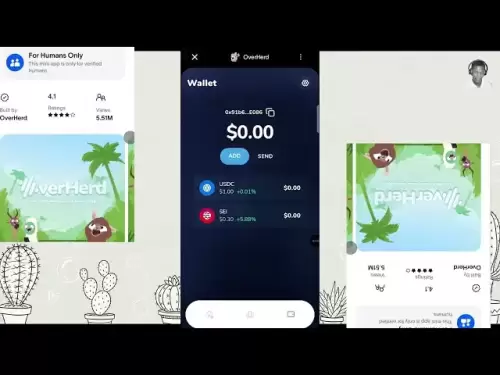-
 Bitcoin
Bitcoin $114200
0.00% -
 Ethereum
Ethereum $3637
0.56% -
 XRP
XRP $2.950
-2.01% -
 Tether USDt
Tether USDt $0.9999
0.02% -
 BNB
BNB $761.0
0.55% -
 Solana
Solana $164.1
-1.38% -
 USDC
USDC $0.9999
0.02% -
 TRON
TRON $0.3332
0.36% -
 Dogecoin
Dogecoin $0.2012
-0.52% -
 Cardano
Cardano $0.7261
-1.41% -
 Hyperliquid
Hyperliquid $37.62
-2.13% -
 Stellar
Stellar $0.3930
-2.65% -
 Sui
Sui $3.441
-0.16% -
 Bitcoin Cash
Bitcoin Cash $563.8
0.70% -
 Chainlink
Chainlink $16.50
0.09% -
 Hedera
Hedera $0.2424
-0.14% -
 Ethena USDe
Ethena USDe $1.001
0.01% -
 Avalanche
Avalanche $22.20
0.00% -
 Litecoin
Litecoin $118.0
-2.48% -
 UNUS SED LEO
UNUS SED LEO $8.991
0.12% -
 Toncoin
Toncoin $3.195
-3.87% -
 Shiba Inu
Shiba Inu $0.00001217
0.12% -
 Uniswap
Uniswap $9.674
-0.21% -
 Polkadot
Polkadot $3.633
1.00% -
 Monero
Monero $295.3
-0.82% -
 Dai
Dai $0.9999
0.00% -
 Bitget Token
Bitget Token $4.321
-0.41% -
 Cronos
Cronos $0.1392
0.73% -
 Pepe
Pepe $0.00001027
-0.89% -
 Aave
Aave $258.5
0.32%
How to open a position in a Bitcoin contract
Opening a Bitcoin contract position involves choosing a reputable exchange, funding your account, enabling margin, selecting the contract type, analyzing market conditions, and placing your order with the desired parameters.
Nov 10, 2024 at 06:46 pm

How to Open a Position in a Bitcoin Contract
Navigating the world of Bitcoin (BTC) contracts can be a lucrative opportunity for those seeking to capitalize on market fluctuations. However, understanding the intricacies of contract trading is crucial to mitigate risks and maximize returns. This comprehensive guide will delve into the step-by-step process of opening a position in a Bitcoin contract, providing you with the knowledge and confidence to embark on this exciting financial endeavor.
Step 1: Choose a Reputable Cryptocurrency Exchange
The bedrock of your Bitcoin contract trading journey lies in selecting a reliable and regulated cryptocurrency exchange. Consider the following factors when making your choice:
- Reputation: Opt for exchanges with a proven track record of reliability, security, and customer support.
- Security: Ensure the exchange employs robust security measures, such as two-factor authentication (2FA), cold storage, and regular system audits.
- Fees: Compare the trading fees and contract commissions charged by different exchanges to optimize your returns.
- User Interface: Choose an exchange with an intuitive user interface that aligns with your trading style and preferences.
Step 2: Fund Your Exchange Account
Once you have identified a suitable exchange, you need to fund your account to trade Bitcoin contracts. Most exchanges offer multiple funding options, including:
- Bank transfer: Typically the most secure method but may incur higher fees and longer processing times.
- Credit/Debit card: Provides instant funding but often comes with higher transaction fees.
- Cryptocurrency deposit: If you already hold Bitcoin or other cryptocurrencies, you can directly transfer them to your exchange account.
Choose the funding method that best suits your needs and convenience.
Step 3: Set Up a Margin Account
Bitcoin contracts are typically traded on margin, allowing you to control a larger position with less capital. To trade on margin, you need to enable a margin account with your exchange. The exchange will require you to complete a risk assessment questionnaire and provide additional documentation to ensure your eligibility.
Once your margin account is approved, you can specify the leverage ratio you wish to use. Leverage amplifies both your potential gains and losses, so it's crucial to carefully consider your risk tolerance and trading strategy before selecting a leverage level.
Step 4: Select the Bitcoin Contract Type
There are two main types of Bitcoin contracts:
- Futures contracts: Obligate you to buy or sell Bitcoin at a predetermined price on a specified date in the future.
- Perpetual contracts: Similar to futures contracts but without a fixed expiry date, allowing you to hold your position indefinitely.
Choose the contract type that aligns with your trading goals and risk profile. Futures contracts provide a defined timeframe for your trade, while perpetual contracts offer greater flexibility and the potential for longer-term exposure to Bitcoin price movements.
Step 5: Analyze Market Conditions
Before opening a Bitcoin contract position, it's essential to thoroughly analyze market conditions using technical and fundamental analysis techniques. This involves studying price charts, indicators, market news, and other relevant information to identify potential trading opportunities.
- Technical analysis: Involves examining price data to identify trends, patterns, and potential price levels of support and resistance.
- Fundamental analysis: Considers economic and market-related factors, such as Bitcoin's underlying value, adoption rate, and regulatory developments.
Step 6: Place Your Order
Once you have identified a trading opportunity, you can place your order to open a Bitcoin contract position. Specify the following details:
- Contract type: Futures or perpetual contract
- Order type: Market order, limit order, or stop-loss order
- Quantity: Number of contracts you wish to buy or sell
Disclaimer:info@kdj.com
The information provided is not trading advice. kdj.com does not assume any responsibility for any investments made based on the information provided in this article. Cryptocurrencies are highly volatile and it is highly recommended that you invest with caution after thorough research!
If you believe that the content used on this website infringes your copyright, please contact us immediately (info@kdj.com) and we will delete it promptly.
- Binance, CZ, and the FTX Fallout: The $1.8 Billion Question
- 2025-08-06 18:30:12
- Brendan Rodgers, Celtic, and the Greg Taylor Role: A Tactical Conundrum
- 2025-08-06 18:50:12
- Coinbase Stock, Investment, and Earnings: Navigating Crypto's Tides
- 2025-08-06 18:55:54
- DALPY Coin: Investor Buzz Swirls Around Upcoming 'Game-Changing' Features
- 2025-08-06 18:30:12
- Fast-Moving Cryptos: Could Pudgy Penguins Deliver High Gains by 2025?
- 2025-08-06 16:30:11
- Crypto Gaming Tokens: August 2025 Investment Opportunities
- 2025-08-06 16:50:12
Related knowledge

Why is my Bitstamp futures position being liquidated?
Jul 23,2025 at 11:08am
Understanding Futures Liquidation on BitstampFutures trading on Bitstamp involves borrowing funds to open leveraged positions, which amplifies both po...

How to report Bitstamp futures for taxes?
Jul 30,2025 at 08:35am
Understanding Bitstamp Futures and Taxable EventsWhen trading Bitstamp futures, it’s essential to recognize that these financial instruments are treat...

Does Bitstamp offer inverse contracts?
Jul 23,2025 at 01:28pm
Understanding Inverse Contracts in Cryptocurrency TradingIn the realm of cryptocurrency derivatives, inverse contracts are a specific type of futures ...

What is the difference between futures and perpetuals on Bitstamp?
Jul 27,2025 at 05:08am
Understanding Futures Contracts on BitstampFutures contracts on Bitstamp are financial derivatives that allow traders to speculate on the future price...

How to find your Bitstamp futures trade history?
Jul 23,2025 at 08:07am
Understanding Bitstamp and Futures Trading AvailabilityAs of the current state of Bitstamp’s service offerings, it is critical to clarify that Bitstam...

Can I use a trailing stop on Bitstamp futures?
Jul 23,2025 at 01:42pm
Understanding Trailing Stops in Cryptocurrency TradingA trailing stop is a dynamic type of stop-loss order that adjusts automatically as the price of ...

Why is my Bitstamp futures position being liquidated?
Jul 23,2025 at 11:08am
Understanding Futures Liquidation on BitstampFutures trading on Bitstamp involves borrowing funds to open leveraged positions, which amplifies both po...

How to report Bitstamp futures for taxes?
Jul 30,2025 at 08:35am
Understanding Bitstamp Futures and Taxable EventsWhen trading Bitstamp futures, it’s essential to recognize that these financial instruments are treat...

Does Bitstamp offer inverse contracts?
Jul 23,2025 at 01:28pm
Understanding Inverse Contracts in Cryptocurrency TradingIn the realm of cryptocurrency derivatives, inverse contracts are a specific type of futures ...

What is the difference between futures and perpetuals on Bitstamp?
Jul 27,2025 at 05:08am
Understanding Futures Contracts on BitstampFutures contracts on Bitstamp are financial derivatives that allow traders to speculate on the future price...

How to find your Bitstamp futures trade history?
Jul 23,2025 at 08:07am
Understanding Bitstamp and Futures Trading AvailabilityAs of the current state of Bitstamp’s service offerings, it is critical to clarify that Bitstam...

Can I use a trailing stop on Bitstamp futures?
Jul 23,2025 at 01:42pm
Understanding Trailing Stops in Cryptocurrency TradingA trailing stop is a dynamic type of stop-loss order that adjusts automatically as the price of ...
See all articles

























































































